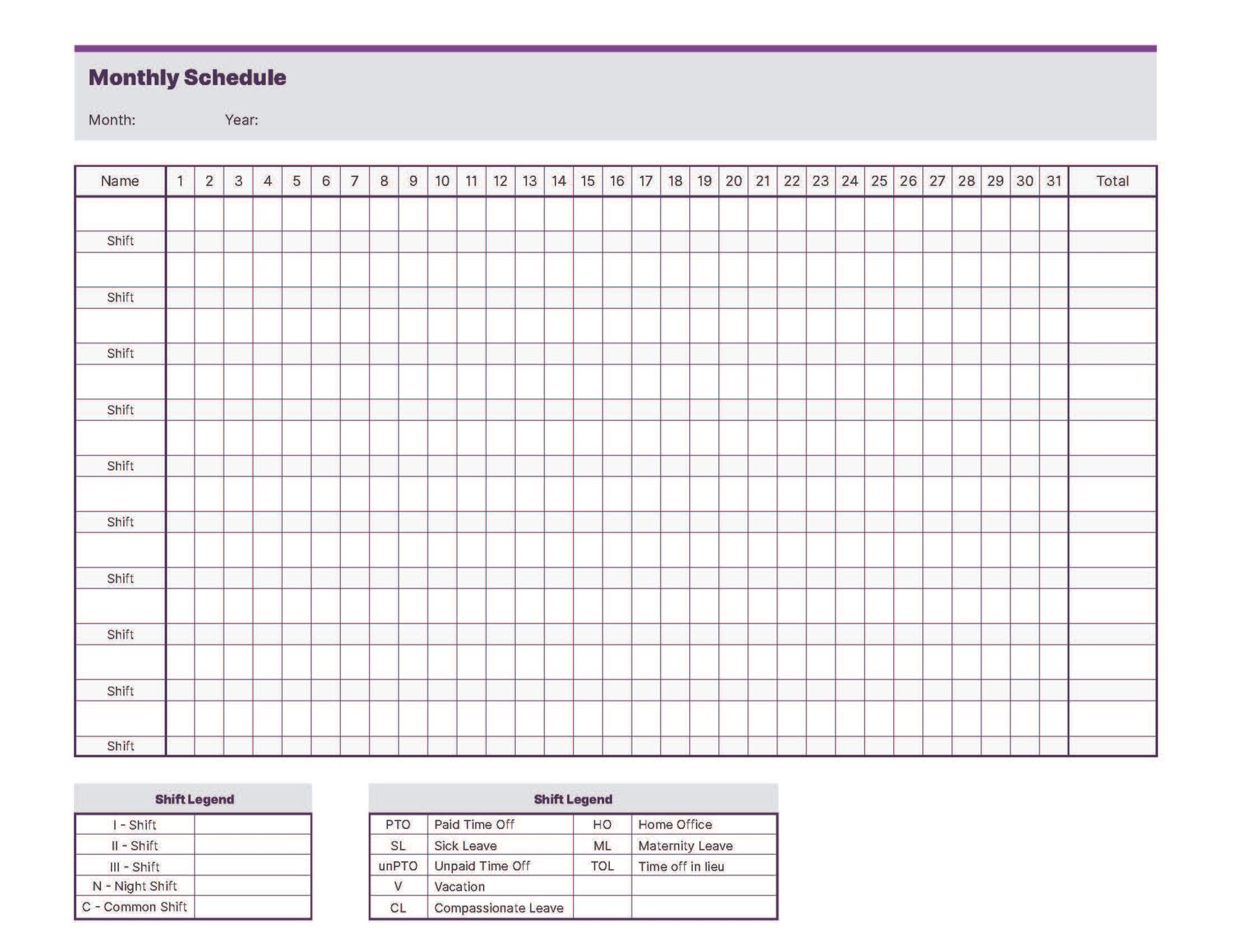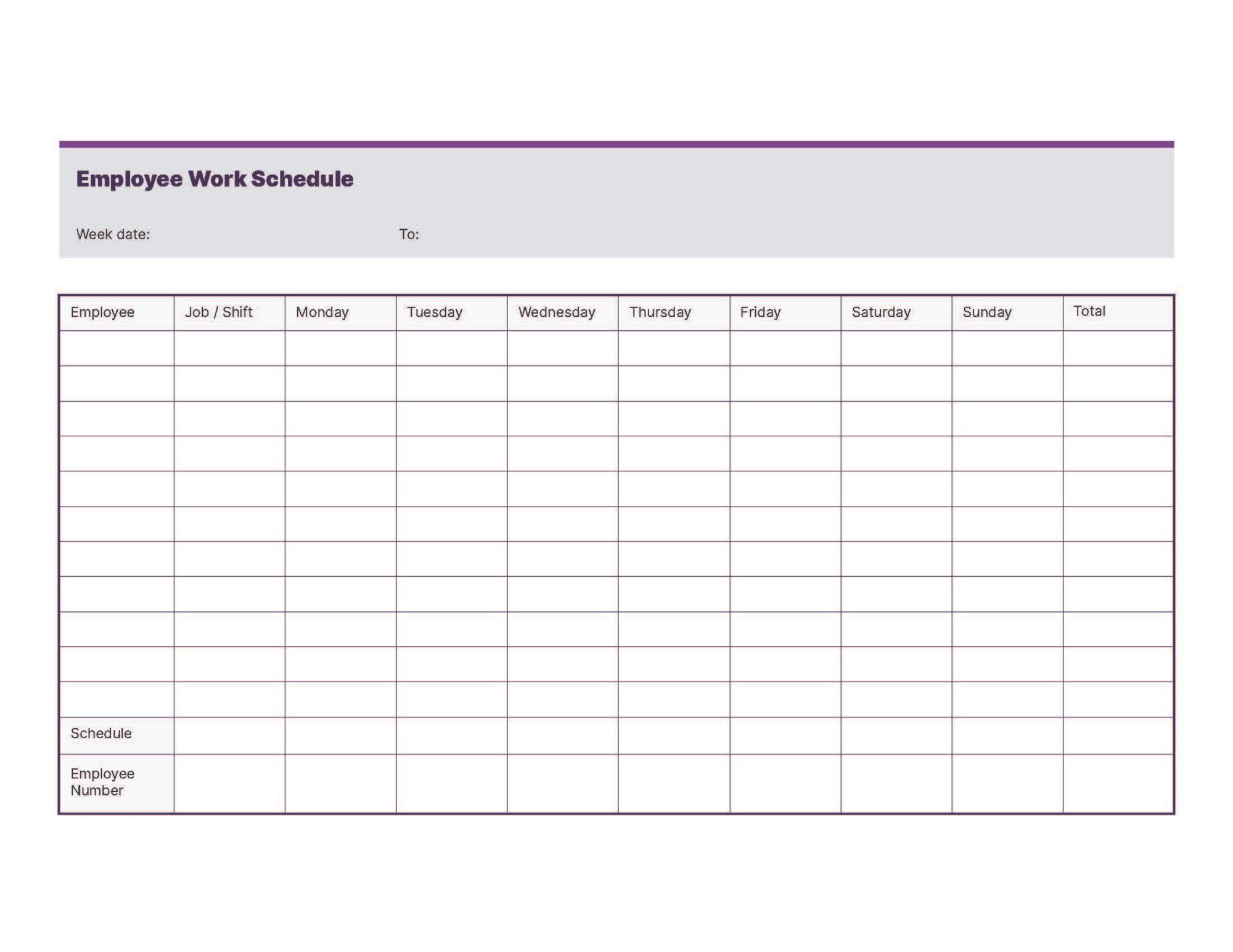

Creating the perfect employee schedule calendar might seem like a pretty big task. But with the right tools, it can be a simple process.
An employee schedule calendar template is one of the tools that can help you easily create a monthly or weekly work schedule. Using a pre-existing template can simplify the task of scheduling so that you can use the time you saved for other important tasks. Because what business owner couldn’t use a few extra hours a week?
We’ll look at some of the most common types of employee schedules and share the six-step process to create an employee schedule calendar. Read on to learn about employee schedule calendars and how scheduling apps can streamline your scheduling process.
An employee schedule, or work schedule, outlines the days and hours when each employee is working. It includes start and end times, days off, and vacation time. Employees’ work schedules will impact their payments, benefits, responsibilities, and labor law requirements.
Using some form of employee schedule calendar is essential to keep your employees informed about their work schedule.
When choosing what kind of employee schedule calendar to use, think about your business structure and the hours your employees typically work. Does your business have set hours, shifting hours, or operate 24 hours per day ? Do you run a 9/80 schedule, 4/10 schedule , rotating schedule , or another kind of schedule? How do your employees track their weekly, daily, or monthly hours?
The answers to these questions will help you decide what type of schedule calendar will be most effective for your business’s needs.
Restaurants, hospitals, factories, hotels, and other businesses in similar industries often use a shift schedule. This gives you the flexibility to move employees from different teams or stations day-to-day while still being transparent to your employees. Usually, the shift schedules run weekly and can be planned out monthly to allow your employees to schedule their off-the-clock obligations.
A monthly schedule is a great way to give your employees as much notice as possible so they can plan their life outside of work. It gives you a clear look into the future with an eye for paid time off, vacation time, and any other upcoming out-of-work days for team members. It can also help keep you compliant with state and federal overtime laws .

A weekly schedule is typical in businesses that run Monday through Friday. A weekly schedule makes it easy for full-time and part-time employees to track their hours, stay on top of overtime, and change shifts when needed. Because you’re working weekly, you may overschedule your employees over the course of a month, so be sure to stay on top of overtime.

Usually reserved for employees who need to complete specific tasks at predetermined times, daily schedules are helpful for keeping employees on task. While daily schedules can help when it comes to day-to-day planning, the narrow scope makes it difficult to plan ahead in any meaningful way. A daily schedule will almost always need to be supported by a weekly or monthly schedule.
There are pros and cons to the different employee schedule calendars. Finding the right one for your business depends on your unique business needs. Above all else, the right employee schedule calendar for you conveys all the necessary information to your team members.
For example, if you run a retail store and are knee-deep in inventory, you may need daily schedules to let employees know when they should be on cash, customer service, or inventory. But you’ll also need a weekly or monthly schedule to make sure every employee knows which days they should be at work—otherwise, there won’t be anyone around to stick to your daily schedules.
When you find the right employee schedule, you’ll be able to let all of your team members know what’s expected of them in terms of their shifts and responsibilities while at work, saving your time and avoiding needless confusion.
When you sit down to create your work schedule, there are a few steps and tips that can help you get through the process quickly and efficiently. Using a template can help you further streamline scheduling your employees. Learn the six steps to create an effective schedule and download our customizable employee schedule calendar template.
As mentioned above, you need to find the employee schedule calendar template that makes the most sense for your business. A seven-day template isn’t necessary if you’re open five days a week. And if your shifts change weekly, it’ll make more sense to have a monthly schedule template for your calendar.
Consider the information you need in your schedule calendar to share with your employees—day of the week, hours, department/task, employee name, start and finish times, etc. Your calendar template should have areas for all of this information so you can answer all your employees’ questions before they ask them.
Each week, you should confirm availability with your employees. It’s easy to assume your team will be able to work the same shifts week after week, but life isn’t that simple. Doctors appointments pop up, cars break down, exams happen—there are always factors that come into play to derail what worked perfectly the week before.
So, instead of being taken by surprise, make a point to check in with your employees each week to confirm their availability.
Be sure to consider holidays, as well. You may need to adjust your business hours to accommodate those taking time to be with friends and family.
If employees have shared their shift preferences with you, be sure to take that into consideration when you sit down to schedule them. While you might only sometimes be able to accommodate every request, making an effort can go a long way with employee engagement and morale.
Whether you’re using a template, scheduling app, or pen and paper, now’s the time to start assigning shifts. Use the employee availability and preference information available to you, and be sure to keep overtime in mind.
Make sure you have enough team members scheduled for each shift. Your schedule should also be flexible enough to account for any unexpected absences or even no-call, no-shows .
Now that your employee schedule calendar is ready, make sure it’s easy for your employees to read. It seems like a no-brainer, but if your employees are confused, you may run into more significant issues down the road.
For example, if you’re using an Excel sheet, make sure it’s easy to read and only includes the most necessary information. This is why a schedule in calendar format is preferable—calendars lay out the information in a chronological order that’s easy to understand.
Whether you email your schedule, post a physical copy, or share it via a scheduling app, finding a way to deliver your schedule that works for your employees is essential. It’s a good idea to share it digitally and post a physical copy somewhere in your workplace.
Check-in with your team to make sure they’re all able to access the schedule. If they can’t access a link via email, find another way to get the schedule into their hands.
Download our free monthly and weekly employee schedule calendar below to get started on next month’s work schedule.
While working with a template can help you save some time when scheduling your employees, manual scheduling has some disadvantages compared to modern scheduling processes.
First and foremost, the time it takes to create manual schedules on paper or in Excel can be better spent on other things. As your business grows and your scheduling needs evolve, scheduling will only become more time-consuming.
When you’re doing everything manually, you’ll need to reconcile employee time sheets against your schedule, taking into account overtime, wages, and whether or not your records comply with state and federal regulations.
Whether dealing with manual schedules or working through the data entry that comes with Excel schedules, you inevitably introduce potential human error into the equation. Human error happens, and it can even occur with scheduling apps and software. But it’s more common with manual scheduling. And that human error opens you up to more serious issues like noncompliance with labor regulations, over- or under-compensation, and even late payments.
Luckily, manual scheduling isn’t the only option available to you. With employee scheduling apps and software, you can maintain control over your employee scheduling and automate some repetitive tasks that take up so much of your time.
The right scheduling app can help you:
With Homebase scheduling , you can build schedules, communicate with your team, and keep everyone accountable, all in one place. Team members can pick up and trade shifts, manage their availability, and request time off in the same app where you create your schedules.
With the auto-scheduler, you can create schedules based on your team’s latest availability, sales forecasts, and labor targets in just a few clicks.
Save time with the Homebase scheduling app, built for hourly teams. Get started for free .